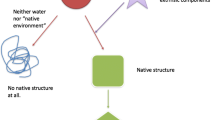Abstract
Microstructuralism in the philosophy of chemistry is the thesis that chemical kinds can be individuated in terms of their microstructural properties (Hendry in Philos Sci 73:864–875, 2006). Elements provide paradigmatic examples, since the atomic number should suffice to individuate the kind. In theory, Microstructuralism should also characterise higher-level chemical kinds such as molecules, compounds, and macromolecules based on their constituent atomic properties. In this paper, several microstructural theses are distinguished. An analysis of macromolecules such as moonlighting proteins suggests that all the forms of microstructuralism cannot accommodate them.
Similar content being viewed by others
Notes
I am grateful to an anonymous referee for pointing out the problem of environmental conditions in determining molecular shape.
In contrast, M1 concerns the instances of natural kinds. However, we should not conclude that this problem leads to the rejection of M1, because as we have seen above isomerism is not a problem for this form of microstructuralism anyway.
Heteropolymers can be branched or crosslinked. Branched polymers have branches of considerable length and are bonded to the main chain at several points. Network polymers have three-dimensional structures with each chain being connected to all others at various points. Network heteropolymers at higher levels of complexity can have many heterogeneous monomers in cross-linking chains.
The glass transition temperature is the temperature at which the monomers become free to rotate and so the polymer loses its glassy state. The way in which the monomers are crosslinked also radically affects the glass transition temperature. For example, the presence of side chains off the main chain increases the class transition temperature of the polymer by restricting bond rotation (Young and Lovell 1991: 295–300).
See Consortium (2004).
These natural kind categories often crosscut each other. In author (forthcoming), I argue that crosscutting categories need not entail conventionalism about natural kinds.
Tompa et al. (2005): 488 have argued that structurally disordered proteins have followed a different evolutionary path. Traditional moonlighting proteins were thought to have only one function and then to have developed further functions because of large portions of their unconstrained surfaces. In contrast, it is more likely that the functions associated with structurally disordered proteins have co-evolved since the same binding region is responsible for distinct functions.
See Consortium (2004).
References
Bogaard, P.A.: The philosophical content of quantum chemistry. In: Bogaard, P.A., Treash, G. (eds.) Metaphysics as foundation—essays in honor of ivor leclerc. State University of New York Press, Albany (1993)
Consortium: Finishing the euchromatic sequence of the human genome. Nature 431, 931–945 (2004)
Ellis, B.: Scientific essentialism. Cambridge University Press, Cambridge (2001)
Ellis, B.: The philosophy of nature. Acumen, Chesham (2002)
Ellis, B.: Physical realism. Ratio 18, 371–384 (2005). Reprinted in Metaphysics in science, Drewery, A. (ed.). pp. 1–13. Oxford: Blackwell (2006)
Hendry, R.F.: Elements, compounds and other chemical kinds. Philos. Sci. 73, 864–875 (2006)
Jeffrey, C.J.: Moonlighting proteins. Trends Biochem. Sci. 24, 8–11 (1999)
Jeffrey, C.J.: Multifunctional proteins: examples of gene sharing. Ann. Med. 35, 28–35 (2003)
Jeffrey, C.J.: Molecular mechanisms for multitasking: recent crystal structures of moonlighting proteins. Curr. Opin. Struct. Biol. 14, 663–668 (2004)
Jeffrey, C.J.: Moonlighting Proteins–an update. Mol. BioSyst. 5, 345–350 (2009)
Needham, P.: What is water. Analysis 60, 13–21 (2000)
Piatigorsky, J.: Lens crystalins. Innovation associated with changes in gene regulation. J. Biol. Chem. 267, 4277–4280 (1992)
Tobin, E.: Crosscutting natural kinds and the hierarchy thesis. In: Beebee, H., Leary, N. (eds.) The semantics and metaphysics of natural kinds. Routledge Studies in Metaphysics (Forthcoming)
Tompa, P.: The functional benefits of protein disorder. J. Mol. Struct. THEOCHEM 666–667, 361–371 (2003)
Tompa, P., Csermely, P.: The role of structural disorder in the function of RNA and protein chaperones. FASEB J. 18(11), 1169–1175 (2004)
Tompa, P., Szasz, C., Buday, L.: Structural disorder throws new light on moonlighting. Trends Biochem. Sci. 30(9), 484–489 (2005)
Van Brakel, J.: Philosophy of chemistry. Leuven University Press, Leuven (2000)
Wooley, R.G.: Must a molecule have a shape?. J. Am. Chem. Soc. 1073–1078 (1978)
Young, R.J., Lovell, P.A.: Introduction to polymers, 2nd edn. CRC Press, London (1991)
Zeidler, P.: The epistemological status of theoretical models of molecular structure. Hyle—Int. J. Philos. Chem. 6, 17–34 (2000)
Acknowledgments
I am grateful to Alexander Bird, Richard Boyd, John Dupré and Jessica Wilson for advise and comments on earlier versions of this paper. I also wish to acknowledge the AHRC for financially supporting a period of postdoctoral research, as a core researcher on the metaphysics of science project, during which this paper was written.
Author information
Authors and Affiliations
Corresponding author
Rights and permissions
About this article
Cite this article
Tobin, E. Microstructuralism and macromolecules: the case of moonlighting proteins. Found Chem 12, 41–54 (2010). https://doi.org/10.1007/s10698-009-9078-5
Published:
Issue Date:
DOI: https://doi.org/10.1007/s10698-009-9078-5




